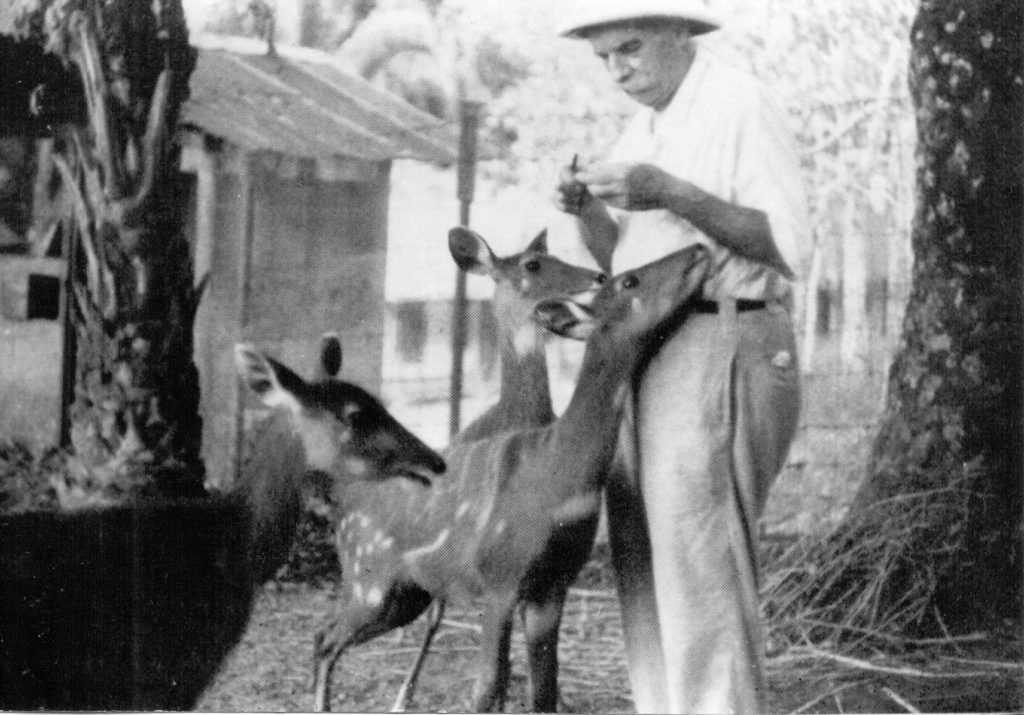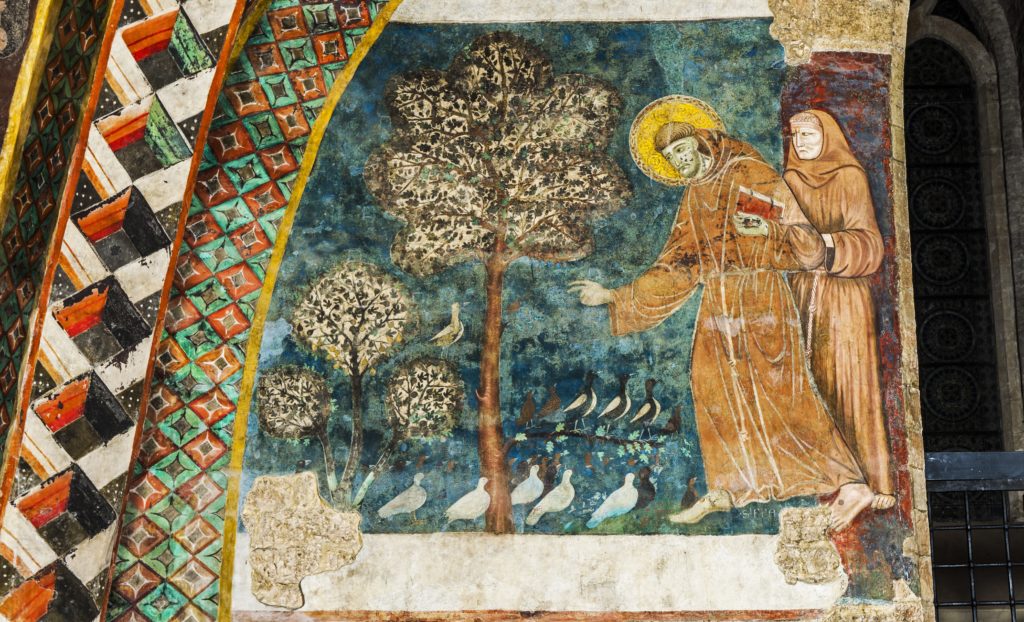
Live and let live!
In simple terms, the philosophy of LIFE UNION can be summarized with this, for some, seemingly trivial though profound motto. It expresses that every living entity within the great whole that represents the universe, has the same intrinsic value as a part of it. This intrinsic value of every living being should not be confused with its utilitarian value for humans, or such values for other life forms or lifeless things. From their intrinsic values derive rights of all living beings to exist.
The motto “Live and let live” also underlines the special responsibility of humans towards conspecifics and other living beings. This responsibility to all living entities comes to all normal people due to their unique mental abilities. Because no matter how intelligent animals are, they could not be able to take that this responsibility. It is all the greater, as people often misuse their mental abilities to dominate fellow human beings and other sentient beings in their choosen position as rulers of the weaker. Such behavior is without any respect, as ruling ideally involves the responsibility of caring for the well-being of the ruled.
“Live and let live” has never meant that humans must not kill other living beings, otherwise they would inevitably have starved or frozen to death from the beginning. Because “let live” in this motto also refers to the people themselves. It means that humans are allowed to kill other living beings, indeed they have to do so, in order to survive. For the vital food of all animals and of people who have developed naturally from them during human evolution, consists almost entirely of formerly living organisms. Rather, the words “let live” calls upon people to abstain from arbitrary and ethically questionable killing and injuring of other living beings, as well as from persecution and torture of fellow human beings and animals. Moreover “let live” is the request to act as consciously as possible and to consider the consequences of our own behaviour for other lives. This words call for the utmost caution to minimize unwanted damage to other living things and habitats through personal negligence. Finally, it is important to mention that in the three letters of the conjunction “and” of this motto is hidden an indication towards ecology, which points to the mutual dependencies in the realm of life, of living things and their habitats, as well as between these natural units.
This motto summarizes the holistic view that enabled our ancestors to live for thousands of years in harmony with nature, of which they were a crucial part, because of their mental capacities. Everything indicates that only such a holistic and respectful attitude of man towards all life and natural things can avert the looming disaster on Earth, regardless of whether this necessary ethical revolution is triggered by philosophical or by spiritual awakening.

Ethical opposites
For at least two thousand five hundred years, philosophers and other scholars have been discussing the role of humans in the realm of life. Despite all the advances of life sciences, these capture up to now only a very tiny fraction of all the species present in the realm of life and of those already lost forever. Of all the species registered so far thanks to natural sciences, they seldom know much more, than their anatomical characteristics. To make matters worse, man-made extermination of species and destruction of natural habitats, which is exponentially accelerating, cements most of these gaps in knowledge about life on Earth forever. Even without considering the physiological limits of the human senses, the inevitable subjectivity of the mind and the total ignorance of extraterrestrial life, it becomes very clear that no one, not even the totality of the uncounted generations of scholars, who have been discussing extensively the role of humans in the realm of life for millennia, understands more than a minute fraction of this realm, which has been for so long subject of their debates! Regardless of the ongoing intellectual arrogance of mankind, worldviews have emerged throughout history, which can be classified in two categories with different ethical ethical perspectives:
The prevalent category of those worldviews are classified as anthropocentrism or human centeredness. As the names indicate, they place mankind at the center of the cosmos and above all other life for no apparent reason. They are responsible for the vast majority of environmental problems of all kinds. The only reasons proposed by their adepts to justify this privileged position of humans are their mental abilities, or religious arguments, such as the assertion of Christian theology, that man was created as the image of God. Anthropocentric perspectives only endorse people’s own values and derived rights. In contrast, all non-human beings or natural phenomena are only attributed utilitarian values. They have no right and protection interests of their own and serve human interests first and foremost. Anthropocentrism is considered by many critics to be ethical racism and often called specism.
Within anthropocentrism, self-centered or ego-oriented sets of values are distinguished from social or altruistic sets of values. Self-centered values form the basis of hedonism, which emerged in the ancient world, claims the quest for pleasure and enjoyment as the most important principle and aims at one’s own well-being. Characteristic symptoms of self-centered values besides the strong self-centeredness are the tendency for indulgence and the overvaluation of material possessions.
The social sets of values within anthropocentrism differ among themselves according to the extent of their respective moral communities. Most of them only concede inherent values and special rights to a certain group of people, such as a family group, a religious community or a whole nation, but seldom give all people own values and rights to protection.
Opposed to anthropocentrism dominating our society is the second category of so-called self-transcending environmental ethics. As their name indicates, their moral communities extend far beyond human beings, which is why they are to be considered as ethically superior to anthropocentrism: the lowest level of self-transcending environmental ethics above the one of anthropocentrism is reached by pathocentrism, which concedes human beings as well as all living beings capable of feeling pain, mostly higher vertebrates, inherent values and derived rights to protection. The next higher level regarding moral communities, is reached by biocentrism, which includes all living things, attributing them values by their own and deduced rights to be protected. The justification of the biocentric environmental ethic emphasizes that even painless creatures have a self-interest in the protection of their lives and therefore also have their own values and their own rights. Its most prominent representative was Albert Schweitzer (1875-1965), whose famous saying “I am a living being, that wants to live in the midst of living beings, that wants to live” succinctly sums up biocentric ethics.

source: © Deutsches Albert-Schweitzer-Zentrum Frankfurt a. M. (Archives and Museum)
From the ethical point of view, biocentrism, and even more pluralistic eco-centrism or holism, the latter of which grant inherent values and protective rights not only to all living things, but also to all natural habitats and landscapes, as well as to conceptual units such as all species, biodiversity and the biosphere, reach the highest levels.
Deep ecology
The emergence of the modern environmental movement also sparked the interest of philosophy in environmental protection, which from then onwards, intensively dealt with environmental ethics. This discipline spawned a new generation of philosophers, some of whom sought applicable concepts for responsible interactions of humans with their environment. One of them was the Norwegian philosopher Arne Næss (1912-2009), who established himself as one of the most important thinkers of the new environmental movement, thanks to his concept of “deep ecology”. With concrete guidelines, the principles of the deep ecology platform, he wanted to lead the people to an attitude, that entails less violent and less consuming behavior towards the environment [*]. Deep ecology is based on a holistic view and therefore convinced, that everything is connected with everything, and thus follows the intuitive ethic, which evolved in primeval times and is the only one sustained over many thousand years. In this sense, it emphasizes the importance of all parts for the whole and assigns an intrinsic value and grants the right to an undisturbed existence not only to humans, but also to all other living beings, species and natural habitats. Contrary to ecology, which is free of values, deep ecology builds on ethics based on high ethical principles and understands itself as the answer to the fundamental question of how people should behave responsibly within the earthly community of all life and all things. Naess unmasked the widely spread opinion, which causes multiple death and destruction, according to which people have the right, due to their mental abilities, to exploit and destroy the rest of nature. Moreover, he referred the responsibility for universal care to humans, and only to them, for that very reason. This attitude of Naess shared among others the Austro-American philosopher and biocentrist Hans Jonas (1903-1993), who emphasized the trustee role of mankind for all nature. Naess, with his respectful and practice-oriented approach, like others before him, sought a positive alternative to the anthropocentric mindset, that is fatal to life and harmful to the environment. Already in the early 1970’s, he proposed deep ecology as alternative to the “shallow ecology movement”, which pursues the protection of the environment in the spirit of anthropocentrism, with the main purpose of human survival on earth. In this context, Naess and then the Austrian philosopher Peter Kampits and others called for the term “environment” to be replaced by “fellowship” in order to counteract the misleading and momentous mental separation of people from their habitats and their demarcation from the rest of nature.
The philosophy and objectives of LIFE UNION are broadly similar to those of deep ecology, which, as timely remake of the millennia-proven holism of animistic communities, deserves worldwide acceptance and maximum support.
The desecration of nature
Until just before the beginning of our era, the environment was not only the source of the resources needed by humans for their survival, but also a natural fabric of dwellings and places of worship of their deities. The rules of their animistic religions took people’s fears of dangerous animals and of scaring natural phenomena and ensured the survival of the ethnic groups directly dependent on nature over many thousands of years. Because these people, as part of their natural way of life, had recognized many dependencies of living beings on each other and on their habitats well before the emergence of ecology, their natural religions occupied not only other living beings and species, but also vital habitats and things like the sky, planets and stars, clouds, thunderbolts and thunder, as well as waters, mountains and other landscapes with a multitude of deities who were respected and often esteemed.
The Creation Commitment of the Old Testament drove all these deities out of the natural environment and the minds of our ancestors. With this definitive “desecration” of nature through the monotheism of the jewish, then the christian religion and subsequently also the Islam, the fears of the people from punishments by animistic deities, who previously resided in their neighborhood, disappeared. This made the plundering of natural resources socially acceptable for the first time. With the removal of the long-established deities, the explicit mandate of the dominion over the nature purified of idols came from the new and only God to man. Thus it says: “And God said, Let us make humans, a picture that is like us, who reign over the fishes in the sea and over the birds under the sky, and over the cattle, and over all the Earth, and over every worm that creeps on the earth … be fruitful and multiply, and fill the Earth and subdue it and reign over the fish in the sea and over the birds under the sky and over all beasts that creep on the earth “(1 Pet. Book of Moses, 1, 26 and 28). In the eighth psalm, after accepting the divine mandate, man asked “… what is man, that you remember him, and the child of man, that you accept it? You have made him a little lower than God … You have made him master over your hand´s creation, everything you have put under his feet, sheep and oxen all together, as well as the wild beasts, the birds under the sky and the fish in the sea and everything that permeates the oceans … ” The sanctus to subjugate all non-human beings and the rest of nature highlights the primary responsibility of monotheism for the unlimited exploitation of the environment and the destruction of creation by humans.
With the diminution of nature from a sacred structure to a kind of global self-service store for the sole favorite of the new god, monotheism ushered in the era of radical anthropocentrism that continues to this day, in which, until not so long ago, any natural mysticism ran the lethal risks of heresy. A conciliatory exception in this long history of religious suppression of non-human nature is Saint Francis, who, according to tradition, could put into perspective the Christian mandate over nature in his sphere of action, without being sacrificed as a heretic. He embodied humility and concern for other forms of life, thereby coming very close to the holistic attitude, which is kind of the opposite of the anthropocentrism of his church and society. Perhaps he wanted to lead the church out of the anthropocentric impasse with his sometimes cosmologically oriented and popular sermons, but unfortunately failed in these attempts.

The devaluation of nature
After the religious upheaval of monotheism, which had banished all well-tried deities from the universe in its sphere of influence, the way was clear for the storm of the god’s domicile on Mount Olympus. In parallel to its purge of all important gods and goddesses, the other gods and demigods were successfully driven out of ancient Greece. Step by step, all the old cults of the gods, including the pantheism glorifying nature, fell into perpetual oblivion. Responsible for this was the triumph of the “Logos”, the logical thinking, which was magnified by hellenistic philosophers such as Socrates (470-399 BC), Democritus (460-371 BC) and especially Plato (427-348/347) and Aristotle (384-322 BC). Their reduction of nature, including mankind, to rationally comprehensible individual aspects of it survived until today, continuing its devaluation from the all-embracing unity to the great machinery under human control. After the decisive waves of attack against nature on the part of monotheism and the rationally focused greek philosophers, others followed. In these later attacks, mathematical reductions of nature were used as spearheads. The lance bearers of these attacks against nature were universal scholars such as Johannes Kepler (1571-1630), Galileo Galilei (1564-1642) and Rene Descartes (1596-1650), which are celebrated to this day. Galileo followed Kepler’s view, according to which the human mind was shaped in a way, that it could understand only quantities, and limited himself to material aspects of the world, while he neglected intangible qualities as superfluous. Descartes believed that animals, as living things that can not think, are essentially nothing more but complex machines. His declared claim to make men the masters and owners of nature by means of mathematics, met with great interest far beyond his death, according to his reputation as a pioneer of the so-called period of enlightenment. All of these influential scholars had studied the mathematics of their time and began to spatially measure parts of nature with the possibilities they had. Since then, the simple quantification of nature with the goal of conquering and dominating it, continues unabated. That the end justifies all means, is shown by a quotation attributed to Sir Francis Bacon (1561-1626), the father of the methodology of science, according to which, nature should be put on the drawbench if necessary, in order to wrest her secrets from her.
Another push for the sustainable devaluation of nature was made by Karl Marx (1818-1883), who also reduced it to its material appearances. Thus he wrote “The mere natural material, insofar as no human work is objectified in it, insofar as it exists as mere matter, independent of human labor, has no value, since value is only objectified labor” and further “Nature becomes .. pure object for man, purely a matter of usefulness; ceases to be recognized as power for itself [**].
The ongoing devaluation, instrumentalization and reduction of nature by humans also threaten to hit themselves, as part of it and to reduce them to instrumentalized consumers and producers of products or even extinguish them. Chief Sealth, often named “Seattle” (1786-1866) of the Suquamish tribe, who partly became witness of the extermination of his people, had recognized the latter danger early, as the quotation attributed to him “What man does to the earth, he does to himself” shows.
[*]: see Naess, A., Sessions, G. (1984/1): Basic Principles of Deep Ecology. In: Ecophilosophy VI.
[**]: see Alfred Schmidt, The Concept of Nature in the Doctrine of Karl Marx, European Publishing House, Frankfurt am Main 1962nd (4th Edition 1993, ISBN 3-434-46209-0 )
